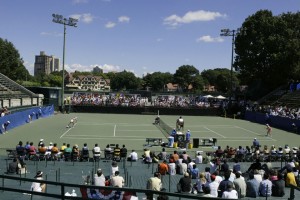By Bob Stockton
The membership of the West Side Tennis Club voted Thursday night not to sell its famed 87-year-old tennis stadium, the site of the modern day US Open from 1923 to 1977, to real estate developer Cord Meyer, who planned to tear down the structure and build condos.
WorldTennisMagazine.com learned the official vote among the voting members of the club was 123-123. Two-third vote was needed in order for the sale of the stadium to take place.
The club will likely restart the process and search for another buyer. Reports indicate that Cord Meyer offered between $8 million and $9 million dollars for the stadium property. Estimates indicate that fees of approximately $12 million would be needed to refurbish the stadium, money that the club does not have. The Wall Street Journal reported that a club newsletter that was sent to members last year, revenues from dues covered “less than fifty percent of the operating expenses of the club.”

New York City’s Landmarks Preservation Commission is currently reviewing whether the stadium deserves official protection from major renovations or demolition. The facility was last fully utilized with fans sitting in the bleachers for a tennis tournament in 1990. So what can this historic slice of American tennis be used for?
Preservationists would like to see some sort of top-level professional tennis played in the stadium, potentially mirroring what the other three Grand Slam cities do the week before the Australian Open, Wimbledon and the French Open. The Kooyong Lawn Tennis Club in Melbourne, the former home to the Australian Open, holds a high-level exhibition featuring players like Roger Federer and Andy Roddick called the Kooyong Classic. Prior to Wimbledon, a similar event called the “Boodles” Challenge is played at the Stoke Park Club in London, while the week before the French Open, the Paris Golf and Country Club hosts the Guinot Mary Cohr Masters exhibition event.
The club has also speaking with the New York Philharmonic about the stadium being its summer home. Other uses of the stadium structure discussed include a hospitality venue for corporate outings, weddings, high school graduations and other celebrations and community events as well as a potential tennis academy with a full-fledged gym and dorm facilities.
A venue for future Davis Cup, Fed Cup or other team events is another option. The horseshoe-shaped stadium was christened in 1923 with the playing of the Wightman Cup matches between Helen Wills and the United States team and Britain. The club has also hosted 14 U.S. Davis Cup matches, the most of any facility in the United States.
The future of the stadium was vigorously debated, striking a nerve with conservationists, tennis fans and historians who felt the stadium should be preserved. U.S. Congressman Anthony Weiner (Democrat, New York) lobbied for the stadium to be saved and asked for the U.S. Tennis Association to become more involved in preserving the stadium. Weiner asked USTA President Lucy Garvin to have one U.S. Open match a year be played at the stadium. USTA President Lucy Garvin and International Tennis Hall of Fame President Tony Trabert have had discussions with club members about how their organizations could help preserve the stadium.
The stadium capacity is 14,000 and has also hosted many legendary music acts through the years including The Beatles, Frank Sinatra, Bob Dylan and Diana Ross.
